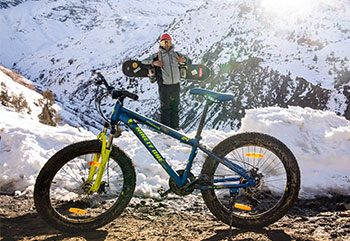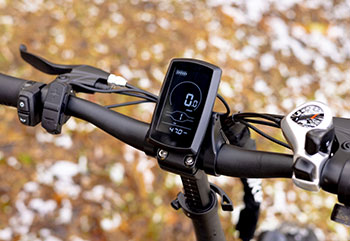How to Fix a Bicycle's Flat Tire: A Step-by-Step Guide

Why do bicycle flats happen?
Whether you ride on smooth roads or rough mountain trails a flat tire is a common issue encountered by cyclists. It's bound to happen eventually but with the right tools and know-how, you can repair it and get back on the road quickly. Before we understand how to repair it, it is important to know why your tire has run flat. Here are some of the possible reasons.
Your Spokes Are Too Long

Occasionally, if your bicycles rim has been repaired, the tips of the spokes will stick through the rivets and create small holes that leak air. If there is a significant impact on the wheels such as during offroad trips, these holes can widen and leak air faster. If your puncture is internal, facing the rim, this might be the reason. The solution is simple, ensure that the points and tips of the spokes are ground down. If you do not have the right abrasive material to get the job done, a mechanic will be able to help you. Additionally, the spokes end with a tape that covers it and prevents damage. Make sure to check that the tape is attached and replace it when you install the tube. Replacing it costs practically nothing so why not do it regularly?
The Tube is Pinched During Installation

Often the rubber of the tube can get pinched and not inflate properly, either because of a hand tool pressing on it, or lack of air to inflate it correctly. This pinch or fold can burst when inflated fully. This can be solved by partially filling the tube and then installing it in the tire. The air will even out any kinks.
Your Tire is Getting Old

Bicycle tires have small hard fibers inside, as the tire ages they can tear and puncture the tube. Additionally, as these fibers tear, you are compromising on the durability and stability of the bicycle itself. A good tire is taut but slightly flexible, if you can turn the tire inside out with ease, it's time to get a new one.
Rough Terrain, Debris, and Pointy things

Sometimes rough terrain can damage the rim, which in turn damages the tube. Pointy debris can directly pierce the tire and the tube and is a common cause of flat tires. If you encounter a flat on a particular route, you may want to consider switching to an alternative or investigating what on the road caused it.
Now that we know what causes a flat tire, lets learn how to fix it.
How to Fix A Bicycles Flat Tire
The following 13 steps are all you need to fix a bicycles flat tire:
1. Gather Your Tools
These are the tools you will need to fix a spare tire, you should always carry them with you when you cycle.
- Tire levers
- Patch kit or spare inner tube
- Pump or CO2 inflator
- Wrench (if your bicycle has nuts instead of quick-release skewers)
If you do not have a bicycle service tool kit to repair flat tires, you can buy an excellent one with everything you need on the link mentioned.
2. Find a Safe Spot
Move to a flat, safe location away from traffic to avoid accidents. Fixing a flat tire takes some time, do not try and rush the procedure.
3. Remove the Wheel
The first step to repairing the punctured tire is removing the wheel from the cycle. If you have quick-release skewers, open them. If your bicycle has nuts, use a wrench to loosen them. Once this is done, proceed to lift the affected wheel off the ground.
4. Release Air
Begin by using a tire lever to pry the tire bead away from the rim on one side. Once this is done, remove the inner tube and partially inflate it to locate the puncture by feeling or listening for escaping air.
5. Locate the Puncture
Suppose you cannot locate the puncture by listening for escaping air, or through clear signs of a puncture. You can submerge the inner tube in water to find bubbles indicating the leak. Lightly sand the area around the puncture with sandpaper or use a rough patch from the patch kit. This is done to make it easier for the patch you will apply in the next step to stick.
7. Apply the Patch
Get out your patch kit, within it, there will be some glue. Apply glue from the patch kit to the sanded area and place the patch over the puncture. Press firmly, and hold for a minute until it sticks.
8. Reinstall the Tube
Begin by stuffing the tube back into the tire and ensure the tire bead is inside the rim. Insert the patched inner tube fully back into the tire, starting opposite the valve. This is done to make it easier to insert the valve.
9. Check for Obstructions
Inspect the tire for sharp objects or debris that may have caused the puncture. This is to ensure that whatever caused the puncture has been safely removed and will not cause any more issues.
10. Reinstall the Wheel
Align the wheel with the dropouts and tighten the quick-release skewer or nuts securely.
11. Inflate the Tire
Use a pump or CO2 inflator to bring the tire to the recommended pressure stated on the sidewall.
12. Check for Leaks
Listen for hissing sounds or feel for escaping air around the tire. If present, double-check for other punctures.
13. Double-Check Everything
Confirm that the tire is seated correctly on the rim, and the wheel is securely attached to the bicycle. This can be done by spinning the wheel and ensuring nothing is loose.

By following these steps, you can confidently repair a flat tire and continue enjoying your ride. Remember, a flat tire is a common occurrence that a good cyclist must be prepared for.Regular maintenance can prevent it but carrying essential tools will help you handle this eventuality with ease.
Related Blogs

Fat Tire Bikes
Fat Tire Cycles: Everything You Need To Know About FtbsFat-tire cycles might just be the vehicle you’re looking for to chart the toughest terrains in the world. They are svelte and stylish, and like a robust willed beast, these fat-tire cycles can conquer just about anything.

Cycling Adventures
Bikepacking: An essential guideCheck out this guide full of important tips to make your next bikepack trip fun, safe and thrilling!

Electric Bicycle
A Novice's Guide To E-Bikes: Everything You Need To Know About Electric BicyclesElectric bicycles are creating waves amongst bicycle enthusiasts, but what is it that everyone is loving about them and why should you know all about them? Read here to know more.

